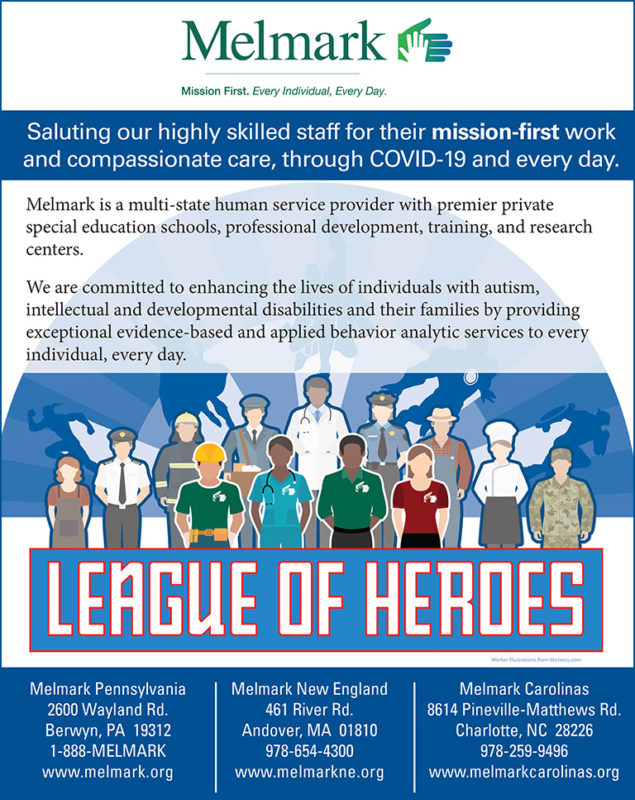COVID-19 abruptly thrust new challenges onto organizations providing intensive behavioral services in a congregate care setting to individuals diagnosed with intellectual and developmental disabilities. The novel virus and its many unknowns required organizations to respond to a rapidly evolving landscape, with employees at every level, from leadership to direct care staff, developing and carrying out a radically transformed service model in real time. All of these changes came while organizations maintained a hyper-vigilant focus on their overall mission. It’s a scenario we will continue to see until a vaccine or scientifically therapeutic treatment is discovered.
Throughout the current pandemic, leadership teams at organizations like Melmark, which serves children and adults with intellectual and developmental disabilities, often accompanied by medical fragility, have developed new ways to meet the needs of a diverse population. The unique aspects of COVID-19 are unprecedented and have made it an elusive foe to combat. These characteristics include the ease of transmission, the relationship between social and physical contact and illness, and the large number of asymptomatic carriers. The virus has led to an increasingly complex set of challenges, which have required both creative and methodical approaches.
Assets Melmark already had in place included strong capabilities in complex care and extensive behavioral skills training systems for staff. These organizational capabilities made it easier to meet the demand for the new skills in public health interventions required in the pandemic.
Particular Vulnerability
A large number of those served by providers like Melmark, especially in the residential setting, are particularly vulnerable, due to underlying conditions that make them more likely to experience serious illness or death as a result of COVID-19. Whether due to medical fragility, a lack of mobility, or the inability to verbalize symptoms, children and adults with developmental disabilities in a congregate care setting require a particularly acute hyper-vigilant approach to mitigating viral spread while balancing their extensive day-to-day care needs.
Many of the individuals requiring this hyper-vigilance of care amidst COVID-19 include adults who are aging. Most have lived the majority of their lives in their current residential setting, and disruption to their routine and in the familiarity of their surroundings could be detrimental to their physical and mental wellbeing. Furthermore, many need specialized nursing care round the clock on a typical day.
The second group of individuals at highest risk are those who are not able to easily be served elsewhere due to severe challenging behaviors secondary to a diagnosis of autism or intellectual/developmental disability. Many of these children and adults may pose risk to him or herself and to others in their environments and are unable to socially distance or maintain wearing a mask. Methodical and systematic assessment is necessary to develop an individualized and tailored behavior intervention plan to address their challenges. Such plans require expert, trained staff, rich ratios of staff to clients, and the ability to implement the plans with fidelity and consistency. While some providers have the option of providing services through telehealth, meaning the individuals they serve could return to their family homes to ride out the pandemic, this is impossible for other organizations. Some of the residents have behavioral challenges too severe to be home due to risk of injury to younger siblings or even parents. Others have aging parents who require their own care, while some have no family to whom they can go home. Indeed, for many clients, the only location in which ongoing treatment is possible is in a congregate care residential setting, necessitating a quasi-medical model for prolonged viral management and mitigation.
Staff and Client Health
COVID-19 has also threatened the well-being of those employed and served by providers. COVID-19 is unusual in that there is significant community spread, and individuals who are asymptomatic are spreading the virus. It continues to be imperative that all parties be protected to the maximum extent possible. This is critical, as programs have self-quarantined and eliminated visitors, in order to ensure the safety of individuals served. In fact, now in many cases the only way a client can contract COVID-19 is from an asymptomatic staff. Most important and most challenging has been the acquisition of personal protective equipment (PPE) to mitigate these issues. With a shortage of N95 masks since the earliest days of the pandemic, obtaining PPE has required hours upon hours of phone calls, emails, orders, cancelled orders and delayed shipments. Due to the diligent work of Melmark’s senior leadership team, every staff continues to have access to their own N95 mask, surgical masks, gloves, non-porous medical gowns (increasingly difficult to obtain), face shields and goggles. Resourcing has included unplanned purchases and donations.
Workforce Depletion
In addition to the factors above, many organizations face workforce depletion, due to a number of reasons including the loss of childcare in their own personal lives with childcare centers and schools closed, the necessity to care for a loved one at home who is sick, and illness or active symptoms. A field that already struggles to find highly skilled staff, due to funding gaps and below living wage reimbursements, continues to face the impact of a shrinking workforce amidst the pandemic.
These workforce issues have been met with a number of creative, effective approaches, such as: asking family members who could take their loved one home to do so, temporarily closing some residences to downsize work locations, implementing ‘hero’ or hazard pay, and allowing staff to voluntarily provide live-in care. Again, these actions and models amount to more unplanned expenses for an already underfunded field.
Maintaining a Mission-First Focus
Melmark provides an interdisciplinary, evidence-based treatment model and takes seriously broad ethical mandates. The use of an interdisciplinary team was crucial in first responding to this pandemic, with health care personnel partnering daily with behavior analysts to rapidly implement changing daily protocols to ensure the health and safety of the whole community. Such broad ethical principles are consistent with Melmark’s core commitments, which include providing compassionate care and maximizing best outcomes. The Behavior Analyst Certification Board’s Professional and Ethical Compliance Code for Behavior Analysts offers several guiding principles that have enforced our commitment to quality care during this pandemic. These include considering the best interests of the client, assuming responsibility for those in our programs, and promoting an ethical culture. These principles and core commitments were met in every decision while also adhering to all guidance from the CDC, governors in multiple states, and numerous regulatory agencies.
Communicating to All Stakeholders
Each division’s COVID-19 Task Force, an interdisciplinary team of experts from across the organization, met daily to discuss measures to reduce risk, mitigate the impact of infection, and re-tool procedures to meet evolving challenges. These teams communicated regularly in a multi-platform approach including: virtual town hall meetings led by the President and CEO and hosting hundreds of staff members, supervisor to staff conversations, behavior skills trainings within residences, access to video and written task analyses on the organization’s intranet and a COVID-19 website, and regular emails. In addition, families and board members were also kept informed via phone calls, video sessions and emails.
Changes to Organizational Structure and Operations
Melmark’s senior leadership team enacted many layers of change to support health and safety protocols.
- Limitation of visitors and symptom monitoring: As soon as the Governors from three states issues stay at home orders, all Melmark programs were closed to all visitors. All staff and individuals had their temperatures taken every two hours to ensure continuous symptom monitoring. Any individual showing COVID-19 related symptoms was immediately isolated, in their own residence if possible. Some went to specially designated homes, set up as isolation units. All staff showing symptoms were tested and sent home immediately. An increased focus on and training in effective hand washing procedures was also initiated.
- Reduction in numbers of people on site and in each location: Schedules were examined to assign fewer numbers of individuals to each site, where possible, limiting the movement of staff between residences and reducing the numbers of staff working in more than one location. Some administrative staff were designated to work remotely, in full or part-time capacities, to reduce the number of people on site.
- PPE provision and training: Full PPE was provided for all staff with COVID-19 cases in isolation. This included N-95 masks, gowns, gloves, and goggles or a face shield. The organization’s health care and professional development teams led virtual instruction and in-person trainings on how to properly wear, don and doff PPE.
- Availability and access to on-site testing: Test kits were purchased and were administered by healthcare professionals within the organization. This on-site testing ensured limited exposure by decreasing trips to external medical facilities, and rapidly provided guidance for intervention moving forward.
- Adherence to CDC and local Boards of Health for all aspects of care: Social and physical distancing guidelines were enforced, including in clinical care (as appropriate) and in training contexts. Many trainings were moved to an online format while those occurring face-to-face were modified to reduce contact.
Summary
COVID-19 arrived abruptly and challenged all aspects of our lives, including the care of the most vulnerable. The need to care for those with developmental disabilities with co-occurring medical frailty and/or behavioral challenges in a safe environment necessitated an immediate, structured, and thoughtful organizational response. The multi-tiered action plan considered the best interests of the individuals and kept the responsibility of the organization to both staff and clients top of mind. Alterations in scheduling, equipment allocation, and the designation of space were important plan components. In addition, vigilant attention to new staff training protocols, prevention, detection and treatment ensured cases could be contained and reduced. While I hope we never again face such an unpredictable and unprecedented medical challenge, the lessons of COVID-19 have served us well to prepare for the continuation of care during public health threats and during other crisis situations.
Rita M. Gardner, MPH, LABA, BCBA is the President and CEO of Melmark, a multi-state human service provider with premiere private special education schools, professional development, training and research centers. Ms. Gardner leads with a mission-first focus on providing exceptional evidence-based and applied behavior analytic services to every individual, every day. Through her robust background in public health, as well as her business acumen, Ms. Gardner has guided Melmark’s entire team on a clear, mission-focused path to ensuring the health and safety of the individuals served and staff employed by the organization.











